Preikestolen, also known as Pulpit Rock, is a seriously impressive tourist attraction in Norway. The landmark is a steep cliff that rises 604 meters above the Lysefjorden and offers stunning views over the fjord.
And given that Preikestolen was actually formed over 10,000 years ago, it’s long been one of the most iconic natural landmarks in Norway.
Every year, more than 300,000 nature lovers visit Preikestolen to experience the breathtaking views from the top of the cliff. Expect the hike to Preikestolen to take about 4-5 hours round trip, with the trek being one of Norway’s most famous mountain hikes and suitable for people of all ages and fitness levels.
If you’re looking to do it as well, keep reading for everything you need to know before strapping on your hiking boots!
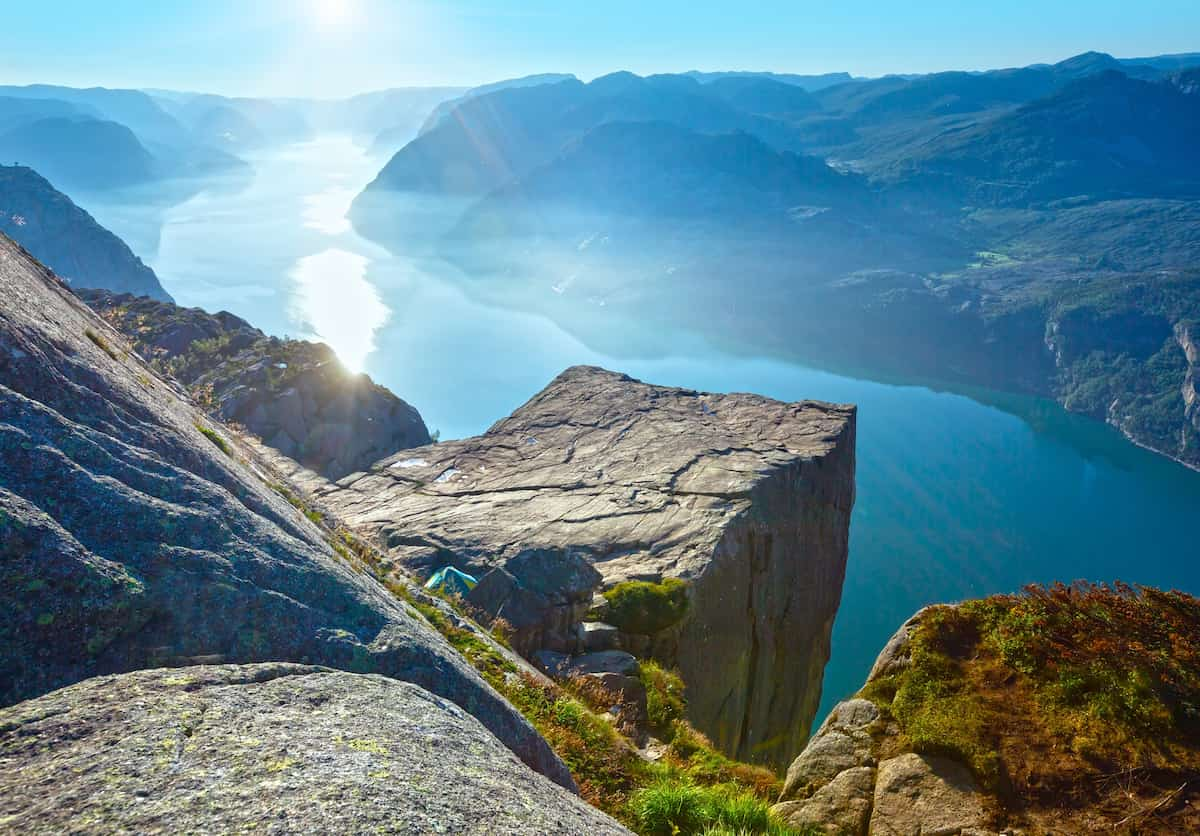
Table of Contents
Where is Preikestolen?
Preikestolen, also known as Pulpit Rock, is a popular tourist attraction located in the municipality of Strand in Rogaland county, Norway. The cliff rises 604 metres above the Lysefjorden, offering breathtaking views of the surrounding landscape.
If you’re planning a trip to Preikestolen, you’ll need to make your way to the town of Jørpeland, which is the starting point for the hike to the top of the rock. Jørpeland is located about 25 kilometers east of Stavanger, the fourth-largest city in Norway.
This is why most people choose to stay in Stavanger when planning to hike Preikestolen.
Looking for where to stay in Stavanger?
My top pick: Thon Hotel Maritim – very centrally located, beautifully decorated rooms and the breakfast is incredible (perfect for fueling yourself up before a hike!)
Want something more luxurious? Check out the Hotel Victoria for the height of classic comfort.
On more of a budget? The Stavanger Bed & Breakfast is just what you need – it’s cozy, clean and close to everything.
Getting to Jørpeland from Stavanger is relatively easy, as there are several transportation options available. If you’re driving, you can take the E39 highway from Stavanger and follow the signs to Jørpeland. Alternatively, you can take a bus from Stavanger to Jørpeland, with several departures per day.
Once you arrive in Jørpeland, you’ll need to make your way to the Preikestolen trailhead, which is located about 7 kilometers outside of town. You can either hike to the trailhead, which takes about an hour, or take a taxi or shuttle bus.
Is Preikestolen the same as Pulpit Rock?
Preikestolen is also known as Pulpit Rock, which can cause some confusion for travelers. However, it’s important to note that Preikestolen is the name of the cliff formation itself in Norwegian, while Pulpit Rock is simply a nickname for it in English.
Despite the different names, both terms are used interchangeably to refer to the same iconic natural landmark.
And whether you call it Preikestolen or Pulpit Rock, if you’re planning a trip to Norway, be sure to add Preikestolen to your itinerary. This breathtaking natural wonder is not to be missed.
How to Get to Preikestolen
To get to Preikestolen, you’ve got a few different options. Taking a car is going to be the quickest, but if you don’t have one, then there are several bus options, including both the public bus and tour buses.
FYI: You can also do a guided hike that includes pick up from your accommodation in Stavanger, which is by far the least stress option.
I recommend this guided Preikestolen hike – check out the amazing reviews to see why!
How to Get to Preikestolen by Car
If you have a car, driving to Preikestolen is a great option to consider. The journey is now easy and ferry-free via the Ryfylke tunnel, which takes approximately 40 minutes to complete the 38 km journey. Just brace yourself for the toll you have to pay to go through the tunnel
(At the very least, the Ryfylke Tunnel is a bit of a tourist attraction in itself as, at 14.4 kilometers long (8.9 miles) long, it’s currently the world’s longest and deepest undersea road tunnel.)
By the way: Various online sources talk about taking your car on a ferry to the town of Tau to get to Preikestolen from Stavanger. You no longer need to take a ferry to get to Preikestolen since the Ryfylke Tunnel opened at the end of 2019.
Of course, feel free to do so, but it’s going to be much quicker to just take the tunnel!
I assume you’ll be using Google Maps to travel from Stavanger to Preikestolen so I won’t include a full turn-by-turn description to get there. However, in brief, take the Stavanger City Bridge out of town, head to the tunnel, continue through the town of Jørpeland and then follow the signs on the left to the start of the Preikestolen route.
Where to park at Preikestolen
Once you arrive at Preikestolen, you can park your car at the Preikestolen Fjellstue parking lot, which is located at the trailhead. There’s an upper and lower car park, but I’d suggest trying to grab a spot at the Preikestolen Lower Parking for ease of access to the start of the trail.
If you’re planning to drive to Preikestolen during peak season, be sure to arrive early to secure a parking spot. The parking lot can fill up quickly, and you don’t want to miss out on the opportunity to hike to the top of this stunning natural wonder.
How much is parking at Preikestolen?
The parking fee is NOK 250 per car, which is valid for 24 hours.
This might seem like a lot, but it’s important to remember that 100% of the parking fee revenue is used to finance daily operations and reinvest in infrastructure. So, by paying the parking fee, you’re actually helping to maintain and improve the site for future visitors.
The car park is open from 6am to 10pm and there’s an electric charging station if you need it. While camper vans can park there during the day, you can’t stay overnight in the parking lot.
And from there, you can begin your hike to the top of the famous cliff!
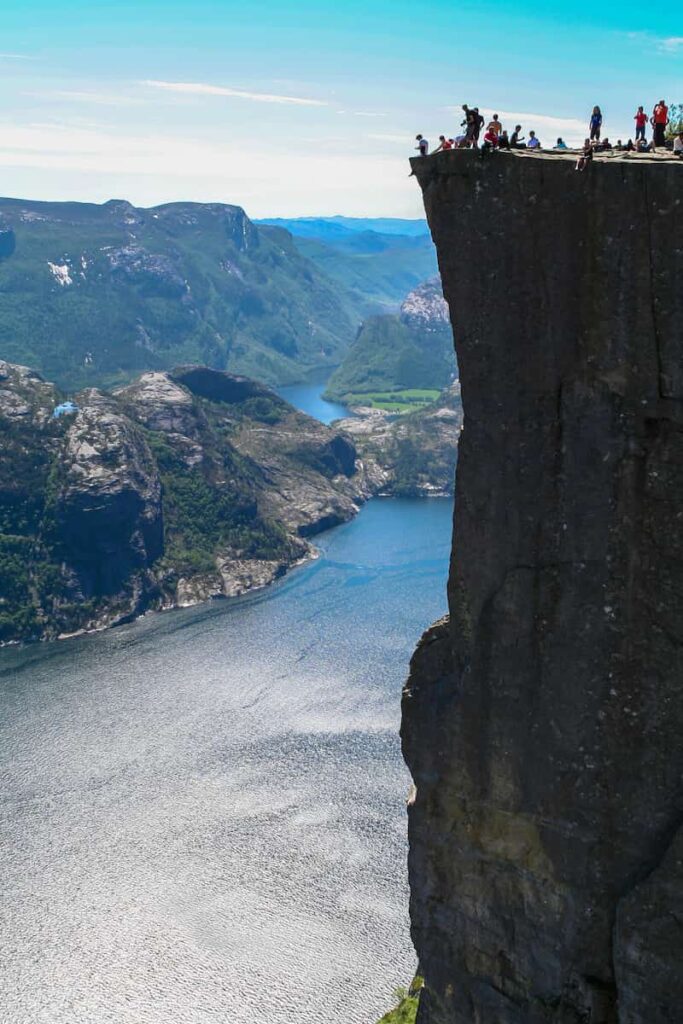
How to Get to Preikestolen by Tour Bus
If you’re looking for a convenient and hassle-free way to get to Preikestolen, taking a tour bus is a great option. There are several tour bus companies that offer trips to Preikestolen from Stavanger and they’re easily the best option if you don’t have a hire car and don’t want to do a guided hike of Preiksestolen (like this one) that includes hotel pick up.
One of the most popular tour bus companies is Go Fjords, which offers daily departures from central Stavanger at 8am. It costs NOK 300 and the bus ride takes approximately 1 hour and 30 minutes, and you’ll arrive at the Preikestolen Mountain Lodge. From there, you can start your hike to Preikestolen.
There’s also the option of purchasing it as a return trip to Stavanger for NOK 450 in total, so you don’t have to worry about transportation back.
With this (very pink – you’ll see what I mean) bus, you’ll have five hours at your disposal to complete the hike, with the bus arriving at the starting point at 9am and leaving at 2pm. This should be sufficient time for most people, including breaks.
You may also be interested in: Norway vs Sweden: Which Should You Visit (or Move To)?
How to Get to Preikestolen by Bus
If you’re on a budget, you can also take the public bus to Preikestolen. Bus 100 is part of the public transport system in Stavanger and takes you most of the way to Preikestolen by stopping in Jørpeland. It costs NOK 30.
From the last stop, you’ll need to walk for about an hour to reach the starting point of the hiking trail (or hitchhike, as some choose to do, but do so at your own risk). This could be an option for you if you have plenty of time and want to save money – but I wouldn’t really recommend it otherwise, to be honest.
How hard is the Preikestolen hike?
Preikestolen hike is one of the most popular hikes in Norway, and is graded as a medium difficulty hike. The trail is 3.8 km each way, with 334 m of elevation. The hike up to the edge of Preikestolen will usually take the average hiker about one or two hours, and the round trip takes around 4-5 hours.
The hike up to Preikestolen can be challenging for some hikers, especially those who are not used to hiking in rough terrain. Given how many hikers do this trail, it’s not going to be the most challenging route in the world, but you’ll certainly need some degree of fitness.
In particular, the trail is pretty rocky, and you’ll have to climb up some steep sections, so it’s important to wear proper hiking shoes and bring enough water and snacks as once you leave the starting point, you’re on your own in that regard.
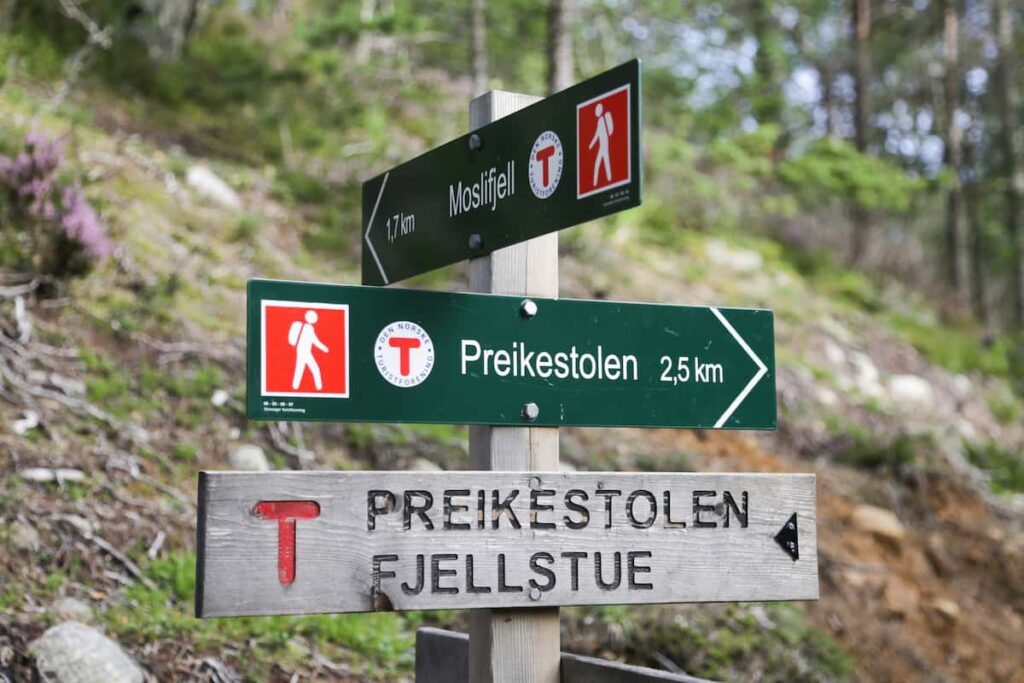
That said, the hike isn’t too difficult for experienced hikers, and many families with children have completed the hike. If you aren’t used to hiking, I recommend that you start with shorter hikes to build up your stamina and experience before attempting the Preikestolen hike.
Alternatively, if you’re not comfortable hiking on your own, there are several guided tours available that will take you to the top of Preikestolen (which I’ll get to just below!). These tours are led by experienced guides who will provide you with all the necessary gear and equipment, as well as safety instructions and tips for making the most of your hike.
What’s the best path to hike to Preikestolen?
The best path to hike to Preikestolen is from the Preikestolen Mountain Lodge (Preikestolen Fjellstue) next to Lake Revsvatnet. This trail is well-marked and maintained, and there are several rest stops along the way where you can catch your breath and take in the stunning views.
You should keep an eye out for the signs marked with red Ts as this is the right trail to follow to the top. Every now and then, you’ll also see spots that show how far you’ve come and how far there is to go – which may or may not be a good thing, depending on how you’re feeling at the time!
But there’s a reason that hiking to Preikestolen is a popular activity in Norway as while it’s not easy, it’s definitely worth the effort. The views from the top are breathtaking, and the sense of accomplishment you feel when you make it to the summit is unbeatable.
Find out more about: 9 Best Things to Do in Undredal, Norway (Ultimate Visit Guide)
Are there guided hikes to Preikestolen?
If you’re planning a trip to Preikestolen, but you’re not sure if you want to hike there alone, you’ll be happy to know that there are guided hikes available. Guided hikes are a great way to experience the beauty of the Norwegian landscape with the help of an experienced guide.
There are several companies that offer guided hikes to Preikestolen. These hikes can range from a few hours to a full day, depending on the company and the level of difficulty you’re looking for.
My top pick: Guided hike to Pulpit Rock – Preikestolen
→ Check latest price and availability
Rating: 4.8 out of 5 (based on 100+ reviews)
Why do this tour: Everything’s taken care of for you, including transportation to and from your accommodation in Stavanger and a guided hike up to Pulpit Rock. The guides on the hike are also renowned for being incredibly friendly and knowledgeable.
While some fitness is required to hike to Preikestolen, you don’t need to be anywhere close to expert-level to enjoy this tour.
What to keep in mind: You’ll need to bring your own lunch and drinks.
Prefer to see sunrise at Pulpit Rock? Then this guided sunrise hike to Preikestolen may be better for you!
How Long Does it Take to Hike Preikestolen?
The time needed to hike to Preikestolen will depend on your fitness level, the weather conditions, and the time of year you visit. In general, the round trip takes around 4 hours for regular hikers. However, if you want to take your time and enjoy the stunning views along the way, it can take up to 5 hours or more.
It’s essential to plan ahead and check the weather forecast before you go. The trail can be slippery and dangerous when it’s wet, so it’s best to avoid hiking on rainy days.
In addition, in the winter, the trail can be covered in snow and ice, making it more challenging to hike, so you absolutely need crampons and a higher level of experience. Understandably, it will also take longer to do.
If you’re traveling with kids, it’s still possible to hike Preikestolen. The trail is relatively easy and suitable for children as young as 8 years old. However, it might take longer to complete the hike with kids, so plan accordingly.
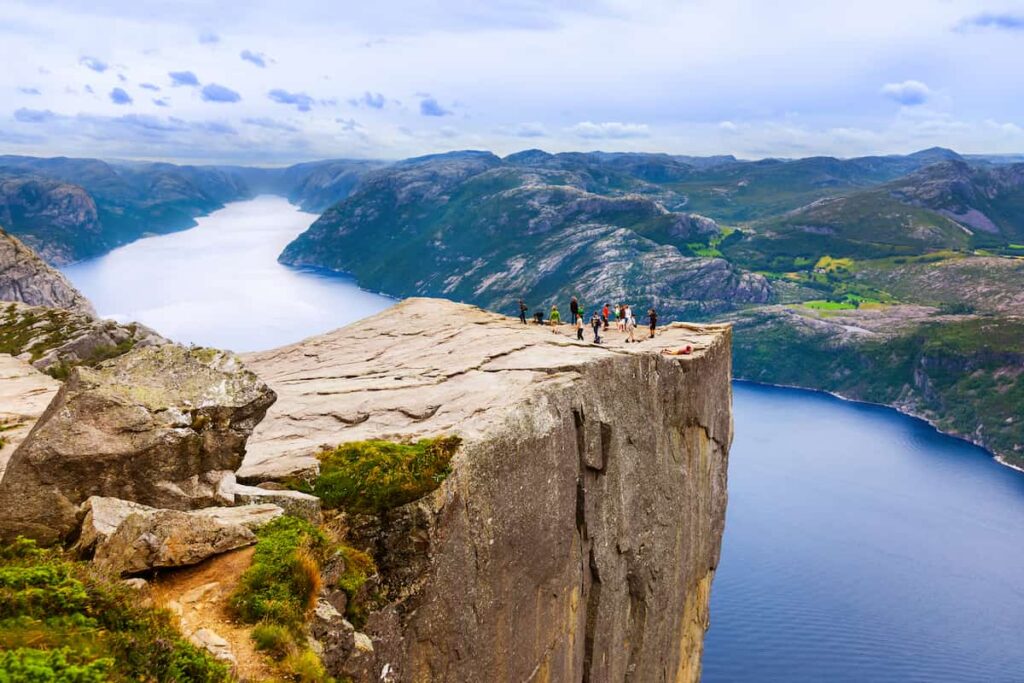
Can you see Pulpit Rock in Norway without hiking?
It’s understandable that not everyone is up for the challenge of a strenuous hike. So, can you see Pulpit Rock without hiking? Absolutely!
While hiking to the top of Pulpit Rock is definitely a rewarding experience, it’s not the only way to see this magnificent landmark. In fact, going by water through the fjord can be just as spectacular.
My top pick: Scenic Fjord Cruise to Lysefjord and Preikestolen
Rating: 4.5 out of 5 (based on 50+ reviews)
Time: 3.5 hours
Why do this tour: This boat tour is a beautiful way to see the fjord and gaze up to Pulpit Rock from the water. Departing from Stavanger, you’ll also see waterfalls, caves and more – not to mention the spectacular views up the fjord.
What to keep in mind: You can buy food and drinks on board, if you want.
Prefer to see Pulpit Rock at high speed? Check out this RIB sightseeing cruise from Stavanger to Lysefjord. Great for those looking for an adrenaline hit!
What should I bring when hiking to Preikestolen?
Before embarking on the Preikestolen hike, it’s important to ensure that you have all the necessary gear and equipment to make the trek as comfortable and safe as possible. Here are some essentials:
- Waterproof and windproof jacket and hiking pants (or shorts, if you’re sure the weather will be warm enough). If you don’t bring any with you, check what’s on offer from the best Norwegian brands in the country, with clothes that will definitely be weather appropriate
- Good socks (ideally wool) to keep your feet warm and dry
- Wool sweater or a thin down jacket for warmth
- Proper mountain boots or light hiking shoes if the weather is dry and warm
- All food and drinks – once you leave the trailhead, there are no opportunities to buy anything further
- A camera – to capture those stunning views at the top!
- Backpack with room for all your gear and equipment
- First Aid kit
- A hat, sunglasses and sunscreen to protect yourself from the sun
- Mosquito repellent to keep the bugs at bay
In particular, it’s important to note that the terrain on the Preikestolen hike can be rocky and slippery, especially if it’s raining. This is why I’d definitely recommend wearing comfortable and durable hiking boots, rather than shoes that may not have good enough grip.
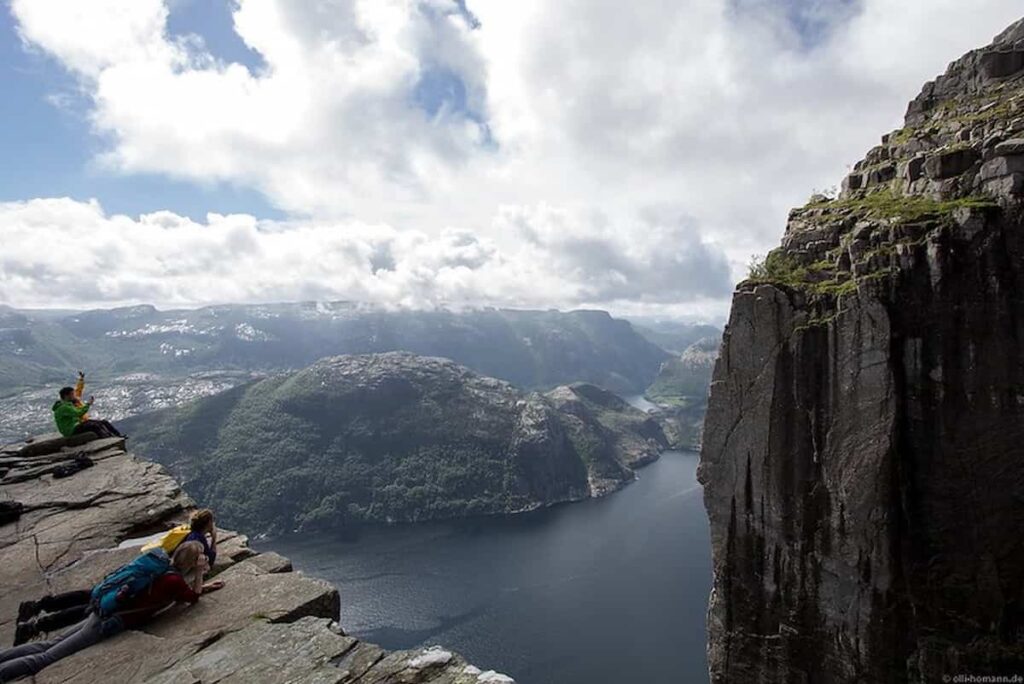
For food, if you don’t buy it before you leave Stavanger, you can also find a Spar supermarket in Jørpeland.
Overall, being prepared with the right gear and equipment can make all the difference in ensuring a safe and enjoyable hike to Preikestolen.
Related: 11 Most Beautiful Norwegian Islands For You To Explore
What time of day is best for Pulpit Rock, Norway?
If you’re planning to hike to Pulpit Rock, one of the most important things to consider is the time of day you choose to start your hike. The best time to hike to Pulpit Rock is early in the morning, before the crowds arrive. This way, you can enjoy the stunning views without having to jostle for space with other hikers.
The hike to Pulpit Rock takes around two hours each way, so it’s best to start early in the morning to ensure you have enough time to complete the hike and enjoy the views. If you’re not a morning person, you can also consider starting your hike in the late afternoon, as the crowds tend to thin out towards the end of the day, although be aware of the fading light.
Another important thing to consider is the time of year you plan to hike to Pulpit Rock. The best time to visit is during the summer months of June to September, when the weather is mild and the days are long.
However, keep in mind that this is also peak season, so the crowds can be quite large. If you want to avoid the crowds, consider hiking during the shoulder season of May or October.
Regardless of the time of day or year you choose to hike to Pulpit Rock, make sure to dress appropriately for the weather and wear sturdy hiking shoes. Bring plenty of water and snacks, and don’t forget your camera to capture the stunning views along the way.
You may also be interested in: Blueberry Season in Norway: The Ultimate Guide (2022)
What else should I know for a Preikestolen hike?
Before you embark on your Preikestolen hike, there are a few key things you should keep in mind to ensure a successful and safe trip.
- Weather: Check the weather forecast before you go and be prepared for changing conditions. It can be sunny and clear at the trailhead, but foggy and rainy at the top. Bring layers and rain gear just in case.
- Trail conditions: The trail can be steep, rocky, and slippery in some sections, especially during wet weather. Wear sturdy hiking shoes or boots with good traction and take your time on the ascent and descent.
- Crowds: Preikestolen is a popular hike, especially during the summer months. Expect crowds on the trail and at the viewpoint. Start early in the morning or hike during the off-season to avoid the crowds.
- Safety: Stay on the marked trail and follow all posted signs and warnings. Don’t climb on the edge of the cliff or take unnecessary risks for a photo. Be aware of your surroundings and watch out for other hikers.
Finally, remember to pack out all of your trash and leave no trace. Preikestolen is a beautiful and fragile natural landmark, and it’s up to all of us to protect it for future generations to enjoy.
Where’s the best place to get photos at Preikestolen?
If you’re planning to hike to Preikestolen, you definitely want to capture some amazing photos of this breathtaking location.
So, where are the best spots to take photos at Preikestolen? Here are some suggestions:
- From the plateau: Of course, the most iconic spot to take photos at Preikestolen is from the plateau itself. You’ll get a stunning view of the Lysefjord and the surrounding mountains. However, this spot can get crowded, so be prepared to wait your turn to get the perfect shot.
- From the right hill across Preikestolen: Another great spot to take photos is from the right hill across Preikestolen. There’s a marked trail that leads to this spot, and you’ll get a unique perspective of the cliff and the fjord below.
- Along the trail: Don’t forget to take photos along the trail as well! There are plenty of beautiful views and interesting rock formations to capture as you make your way up to Preikestolen.
- In the early morning or late evening: If you want to avoid the crowds and get some truly stunning photos, consider hiking to Preikestolen early in the morning or late in the evening. The light at these times of day can be magical, and you’ll have a better chance of getting the perfect shot without other hikers in the way.
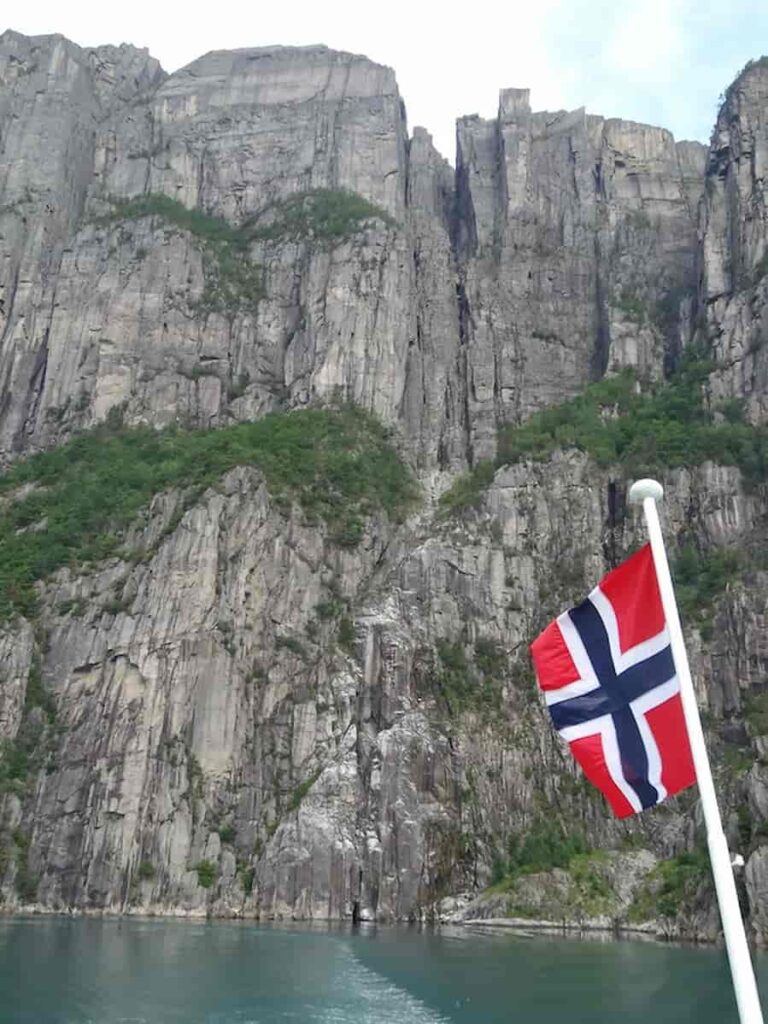
Overall, there are plenty of great spots to take photos at Preikestolen. Just be prepared for crowds if you’re planning to shoot from the plateau, and don’t forget to take some shots along the trail as well. Happy hiking and happy snapping!
What else should I see near Preikestolen?
Here are some of the other attractions you should consider visiting when you’re in the area:
- Kjeragbolten: This is another popular hiking destination near Preikestolen. The Kjeragbolten is a large boulder wedged between two cliffs, and it’s become a popular spot for daredevils to take photos. The hike to Kjeragbolten is more challenging than the hike to Preikestolen, but the views are equally stunning.
- Check out this guided hike to Kjeragbolten – it includes pick up and drop off to your accommodation in Stavanger
- Flørli Stairs: If you’re up for a challenge, consider climbing the Flørli Stairs. This staircase has 4,444 steps and is the longest wooden staircase in the world. The stairs were originally built to provide access to a hydroelectric power plant, but they’ve become a popular hiking destination in recent years.
- Lysefjord: Take a boat tour of the Lysefjord to see the stunning cliffs and waterfalls from a different perspective. You can also go kayaking or paddleboarding on the fjord if you’re feeling adventurous.
- Stavanger: You’ll likely be based here for your hike, but we shouldn’t forget that Stavanger itself is a charming city. The city has a vibrant food scene, a bustling harbor, and plenty of museums and galleries to explore.
- Short on time? This private tour of Stavanger with a local will make sure you experience everything the city has to offer
What is the history of Preikestolen?
Preikestolen, also known as Pulpit Rock, is a natural rock formation located in the Lysefjord of Norway. This iconic landmark has a rich history that dates back over a century. According to the stories, Preikestolen was discovered in 1896 by Thomas Peter Randulff, a bank manager from Stavanger who was on a cruise of the Lysefjord as a passenger.
The story goes that Randulff was so fascinated by the rugged beauty of the fjord that he decided to explore the surrounding mountains. During his hike, he stumbled upon the awe-inspiring Preikestolen cliff.
Since its discovery, Preikestolen has become a popular tourist destination, attracting visitors from all over the world. The name Prekestolen (without the i) was coined around the year 1900 when the local tourist organization, Stavanger Turistforening, wanted to promote the area as a tourist destination.
Over the years, Preikestolen has undergone several changes to accommodate the increasing number of tourists. In the early 1900s, a trail was built to make it easier for hikers to reach the top of the cliff.
Today, the trail is well-maintained and is considered one of the best hiking trails in Norway.
Despite its popularity, Preikestolen remains an important part of Norway’s natural heritage. If you’re planning a trip to Norway, a visit to Preikestolen is a must-see attraction that offers a glimpse into the country’s rich history and natural beauty.
Find out more about: 25 Famous Norwegians Everyone Should Know About
Has anyone ever fallen off Preikestolen?
Preikestolen, also known as Pulpit Rock, is a popular tourist attraction in Norway, attracting thousands of visitors each year. While the steep cliff may look intimidating, it’s generally considered safe for visitors who follow the recommended safety guidelines.
While there have been a few incidents of falls and deaths at Preikestolen, they are relatively rare. According to The Norway Guide, deaths from falling down from Pulpit Rock are very rare, but they do happen every once in a while. Most deaths are from intentional jumps.
One of the most well-known incidents occurred in 2000, when an Austrian woman and Norwegian man died in an apparent pact by plunging to their deaths from the 600-meter (2,000ft) cliff. The incident was widely reported in the media, but it’s important to note that such incidents are extremely rare.
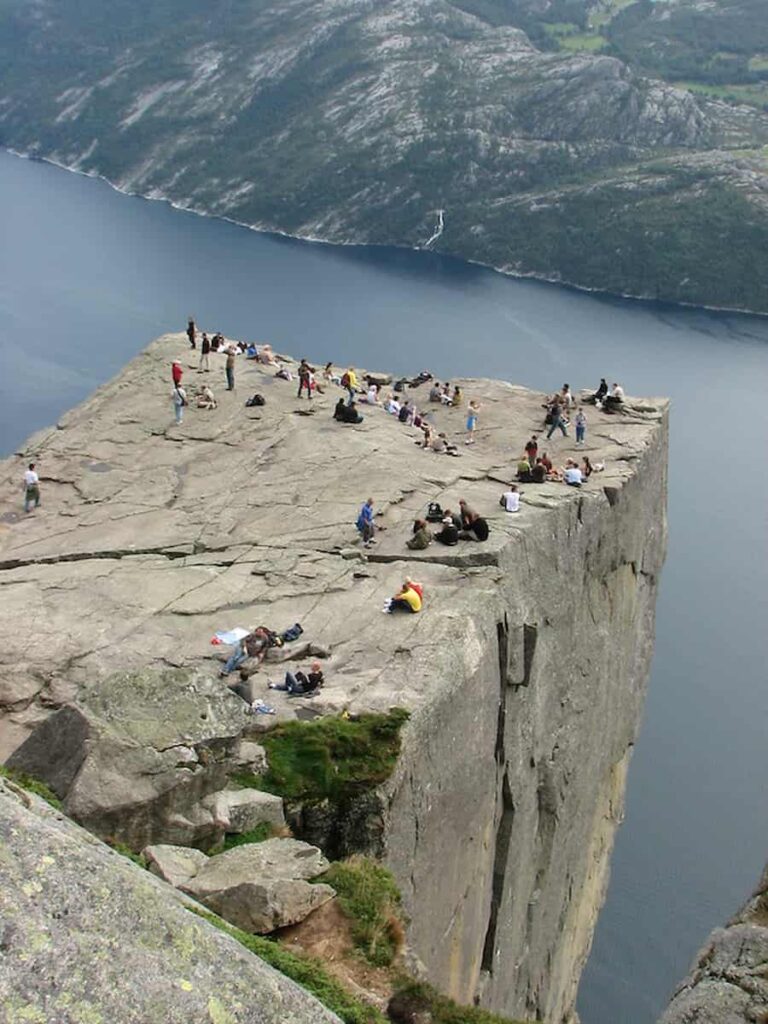
It’s also worth noting that there are safety measures in place to prevent accidents at Preikestolen. Visitors are advised to stay on the designated paths and not to venture too close to the edge of the cliff.
At the same time, there aren’t any fences or other barriers around Preikestolen. The position of the Norwegian authorities on this (and most Norwegians you speak to, actually) is that there’s an element of danger in everything in nature and they shouldn’t have to childproof everything so as to ruin the nature for everyone.
In conclusion, while there have been incidents of falls and deaths at Preikestolen, they are relatively rare and shouldn’t discourage you from exploring this stunning natural wonder.
By following the recommended safety guidelines and using common sense, you can certainly enjoy the breathtaking views without putting yourself in danger.
